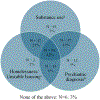Substance Use and Mental Health Comorbidities and Receipt of Specialty Care Among Patients Enrolled in a Low-Barrier HIV Clinic
- PMID: 37351687
- PMCID: PMC11022825
- DOI: 10.1007/s10461-023-04110-3
Substance Use and Mental Health Comorbidities and Receipt of Specialty Care Among Patients Enrolled in a Low-Barrier HIV Clinic
Abstract
Low-barrier care is one model of a differentiated service delivery approach for people with HIV (PWH) who are not engaged in conventionally-organized HIV care. Although psychiatric and substance use disorders are common among patients in low-barrier clinics, approaches to behavioral health service delivery within this context have not been well-described. We conducted a descriptive analysis using retrospective review of medical records to evaluate substance use and psychiatric comorbidities and receipt of behavioral health services among patients in the Max Clinic in Seattle, Washington. Among 227 patients enrolled from 2015 to mid-2020, most had a history of hazardous substance use (85%), a psychiatric diagnosis (69%) or unstable housing (69%) documented in the medical record. Less than half of patients referred for depression treatment (33%) or for opioid use disorder treatment (40%) completed even one specialty care visit. More effective approaches are needed to engage patients in behavioral health services within the context of low-barrier HIV care.
Keywords: HIV; Housing Instability; Mental Disorders; Population Characteristics; Substance-Related Disorders.
© 2023. The Author(s), under exclusive licence to Springer Science+Business Media, LLC, part of Springer Nature.
Conflict of interest statement
Conflicts of interest/competing interests
JCD has participated in research with materials donated by Hologic, Cepheid and Mayne Pharmaceuticals.
Figures

References
MeSH terms
Grants and funding
LinkOut - more resources
Full Text Sources
Medical

